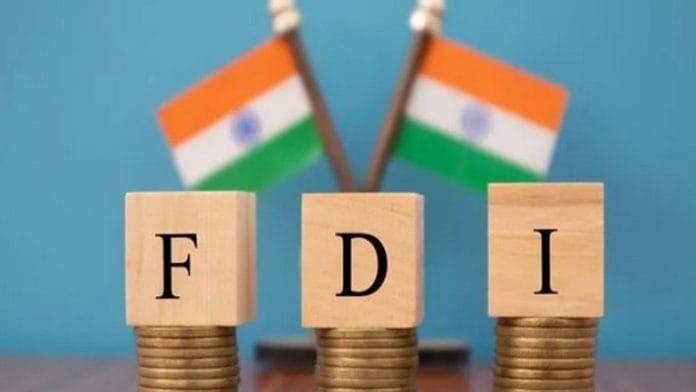Over the past few months, much has been written about developments in foreign direct investment flows into India, and questions have been raised about the government’s ability to attract foreign funds. However, developing a holistic understanding of the situation is imperative before pressing for policy action.
FDI flows across the world were hostage to pervasive economic uncertainty in 2023. Adverse geopolitical developments that began in 2022 spilt into 2023 and kept inflationary pressures elevated. The implementation of a globally concurrent monetary tightening cycle to counter these pressures meant that borrowing costs rose sharply. This heightened uncertainty caused investors to adopt a risk-off approach, and therefore, investment flows declined worldwide. The United Nations Conference on Trade and Development’s (UNCTAD) World Investment Report 2024 bears this out. Global FDI inflows were lower by 2 per cent in 2023, and excluding the impact of flows through certain conduit European economies, the decline is far steeper — at 10 per cent. Both advanced and emerging economies (net of conduit economies) witnessed a fall in inflows by 7 per cent and 15 per cent, respectively. FDI patterns are also being reshaped by a resurgence of industrial policies and trade barriers, particularly in major advanced economies, and the diversification of supply chains, thereby causing multinational enterprises to adopt a cautious approach to overseas expansion.
India’s case
India’s FDI flows have primarily been affected by increased repatriation. Repatriation involves international corporations exiting their investments made over the years on realising returns. Data from the Reserve Bank of India (RBI) on India’s balance of payments reveals that Gross FDI inflows in FY24 totalled $70.9 billion and were only 0.6 per cent lower than in FY23. Meanwhile, the repatriation of FDI increased by 51.5 per cent — to $44.5 billion over this period.
How does one view this surge? A deep dive into private equity and certain financial market developments reveals interesting insights. Multinational companies are capitalising on India’s robust stock market by divesting their ownership stakes in domestic subsidiaries, attracting investors eager to participate in the market’s growth. They are doing so through secondary share sales or block trades and initial public offerings (IPOs). Data by the Global Private Capital Association (GPCA), a non-profit, independent membership organisation representing private capital investors from emerging markets, reveals that India witnessed $25 billion worth of exits backed by private capital in 2023, leading to an increase in deal value and count by 46 per cent and 51 per cent, respectively, on a year-on-year basis. This comes amid a meagre appetite for exit deals elsewhere globally. Factors driving this surge include, among other things, a stable macroeconomic environment, a vigorous domestic investor appetite induced by a rise in retail investor participation, and investor-friendly policies. The GPCA report indicates that the momentum in deal activity, particularly through public market exits, remains intact in 2024 as well. Thus, the increase in repatriations, combined with steady gross FDI inflows, is a testament to India’s growth story over the last decade.
If earlier investments can be exited profitably, it reinforces investors’ confidence in the market and the economy and enhances investor interest. To be a viable investment destination, return of capital is as important as attracting capital. In the last two years, India has demonstrated success in returning capital. So, it is wrong to read it as investors losing faith in India. It is the opposite.
Investment intentions for India remain strong – the nation was the fourth-largest host country for greenfield project announcements and ranked second in international project finance deals in 2023. Apart from ensuring favourable macroeconomic conditions, the government continues to engage with stakeholders to eliminate barriers to investment even as FDI regulations across multiple sectors have already been relaxed. While the low-hanging fruits in facilitating foreign investments have been plucked, future actions lie across all levels of government – national, state, and local.
The Economic Survey 2023-24 notes that investment intentions in new and futuristic sectors such as renewables, artificial intelligence and semiconductors have rapidly risen. Building on these developments will require governments to ensure an educated and skilled workforce and facilitate a vibrant R&D culture while maintaining policy continuity, political stability, reasonable taxes and duties, and quick dispute-resolution mechanisms. One area of improvement lies in enhancing the attractiveness of more states as investment destinations – data on FDI in Q1 from the Department for Promotion of Industry and Internal Trade (DPIIT) indicates that FDI recipience across states remains skewed.
Also read: India must make net-zero goal competitive for small firms, not rely on major corporations
Looking ahead
The global economic uncertainty and tight financial conditions have made investors cautious, leading to lower investment flows. However, it’s important to note that India is now competing not only with emerging economies for FDI but also with advanced nations aggressively pursuing industrial policies that divert foreign investment toward domestic purposes. Despite these challenges, India’s FDI inflows and intentions remain commendable, and the recent increase in repatriation serves as evidence of the nation’s economic rise. It would be premature to question India’s attractiveness as an investment destination.
Looking ahead, as central banks begin the rate-cutting cycle in response to slowing economic activity, investors may adopt a risk-on approach, thereby somewhat normalising global FDI flows. In fact, in the first quarter of FY25, gross FDI flows into India are already 26.4 per cent higher on a yearly basis. Union and state governments recognise FDI’s economic importance to output and employment and will continue to work on making India an even more attractive investment destination.
V Anantha Nageswaran is the Chief Economic Advisor to the Government of India and Bharadwaja Adiraju is a consultant in the Ministry of Finance, Government of India. Views are personal.
(Edited by Humra Laeeq)






